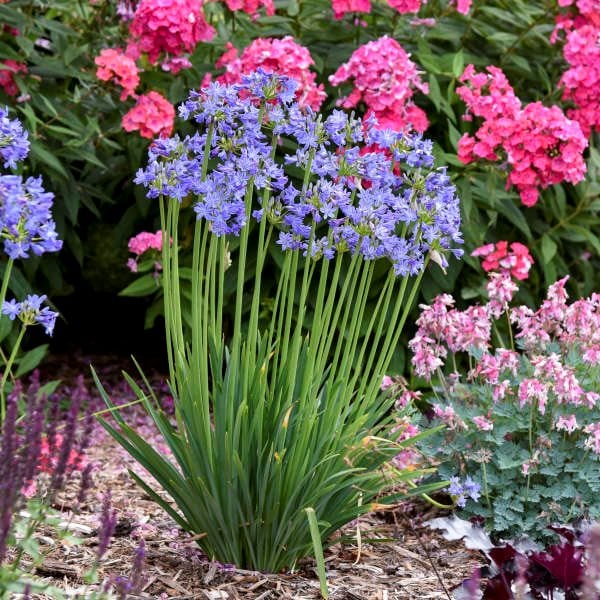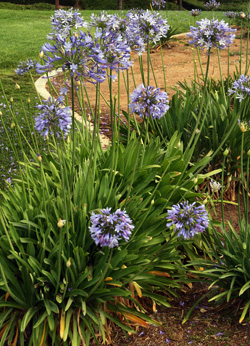Agapanthus Treatment Tips for Lush and Vibrant Flowers
Agapanthus Treatment Tips for Lush and Vibrant Flowers
Blog Article
Mastering the Art of Agapanthus Treatment: Vital Actions for Healthy Growth and Vivid Blooms
In the world of gardening, the cultivation of agapanthus stands as a satisfying undertaking for those who seek to nurture these elegant blooming plants. With their striking flowers and graceful vegetation, agapanthus has actually captured the attention of garden enthusiasts worldwide. Nonetheless, achieving ideal development and vivid blooms requires a nuanced approach that encompasses different vital steps. From selecting the right selection to grasping trimming methods, the trip in the direction of growing flourishing agapanthus plants is complex and holds the crucial to unlocking the complete capacity of these herb gems.

Picking the Right Agapanthus Selection

When picking the best Agapanthus selection for your yard, think about factors such as climate viability, blossom shade, and growth routine. Agapanthus, frequently known as Lily of the Nile or African lily, can be found in a selection of colors varying from shades of purple and blue to white. Pick a bloom color that enhances your existing yard scheme to develop a harmonious landscape. Additionally, take into consideration the environment in your area to ensure the Agapanthus variety you choose can grow in your details conditions. Some selections are extra forgiving of cool temperatures, while others favor warmer environments. Understanding the growth behavior of different Agapanthus ranges is critical for correct positioning within your yard. Some varieties have a clumping growth habit, ideal for boundaries or containers, while others have an even more spreading nature, suitable for ground cover or mass plantings. By meticulously assessing these aspects, you can choose the perfect Agapanthus range to boost the charm of your garden.
Suitable Planting Conditions
Considering the optimal ecological demands is crucial for effective Agapanthus growing. Agapanthus thrives in well-draining soil with a slightly acidic to neutral pH degree. When planting, select a place that receives full sunshine to partial shade. In hotter environments, supplying some mid-day color can avoid scorching of the fallen leaves. Agapanthus plants are sensitive to cold temperatures and ought to be shielded from frost during winter months.
To make sure healthy and balanced development and vibrant flowers, plant Agapanthus light bulbs at a depth of regarding 2-4 inches and room them 8-12 inches apart. Including raw material, such as compost, to the soil can enhance drainage and fertility, advertising durable root development. Mulching around the base of the plants helps preserve wetness and subdues weed growth. Routine watering is essential, particularly throughout the growing season, to keep the soil regularly damp yet not waterlogged.
Watering and Feeding Tips
Maintaining correct dampness levels and providing important nutrients are key elements in the care regimen for Agapanthus plants. When it comes to sprinkling Agapanthus, it is essential to strike a balance. These plants like regularly wet soil yet are vulnerable to root rot if overwatered.
Fertilizing Agapanthus is crucial for advertising healthy and balanced development and respected flowers. Use a balanced plant food, such as a 10-10-10 formula, in the very early springtime as new development arises. Repeat this application every 6-8 weeks throughout the growing period. article source Stay clear of extreme fertilization, as it can cause rich foliage at the expenditure of blossoms. Constantly comply with the manufacturer's guidelines for proper dilution and application techniques. By complying with these watering and feeding ideas, you can guarantee your Agapanthus plants prosper and produce vivid, long-lasting flowers.
Trimming Strategies for Agapanthus
Pruning Agapanthus plants at the ideal times and with proper strategies is critical for keeping their wellness and promoting optimal growth and blooming. The optimal time to prune Agapanthus is in late wintertime or early springtime prior to brand-new development arises. Start by getting rid of any kind of dead or yellowing fallen leaves near the base of the plant. Cut them as close to next page the ground as feasible without damaging the arising shoots.
For flowered stems, wait until the blossoms have perished and after that cut them back to the base. This not just cleans up the plant's appearance however also urges the growth of new flower buds. Deadheading invested flowers can additionally reroute the plant's energy into Read Full Report producing more flowers instead of setting seeds. However, if you want to accumulate seeds for propagation, leave some blossoms to mature and completely dry on the plant.
Keep in mind to use clean, sharp tools to make accurate cuts and reduce the danger of presenting conditions. Agapanthus. Regular trimming will help maintain your Agapanthus looking healthy and cool while making certain a plentiful display of stunning blossoms
Taking Care Of Usual Parasites and Conditions
After ensuring appropriate trimming methods for Agapanthus, it is essential to address usual pests and conditions that can influence the wellness and vigor of these plants. Agapanthus plants are typically durable yet can still succumb particular concerns. One common bug that affects Agapanthus is the Agapanthus gall midget. This little, orange fly lays its eggs in the foliage, causing distorted development and flower buds that fail to open up. To fight this insect, prune and ruin any kind of damaged plant parts and take into consideration utilizing insecticidal soap.
In addition, Agapanthus plants can suffer from origin rot if they are grown in badly draining dirt. By being attentive and taking timely activity against pests and diseases, you can assist your Agapanthus plants grow and generate vivid blossoms. Agapanthus.

Verdict
To conclude, grasping the art of agapanthus treatment involves choosing the ideal range, providing suitable growing conditions, appropriate watering and feeding, proper trimming methods, and addressing usual insects and illness. By adhering to these necessary actions, you can guarantee healthy growth and vibrant blooms for your agapanthus plants. Bear in mind to on a regular basis monitor and maintain your plants to promote their overall health and long life.
To guarantee healthy and balanced development and vibrant blossoms, plant Agapanthus bulbs at a depth of concerning 2-4 inches and area them 8-12 inches apart. By adhering to these watering and fertilizing suggestions, you can ensure your Agapanthus plants flourish and create vivid, durable flowers.
One usual bug that affects Agapanthus is the Agapanthus gall midget. In addition, Agapanthus plants can endure from root rot if they are planted in poorly draining pipes soil. By following these necessary steps, you can make sure healthy and balanced development and dynamic flowers for your agapanthus plants.
Report this page